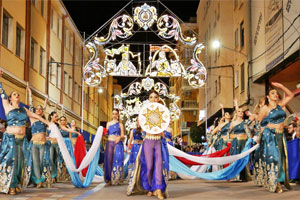Almansa Major Festivities

What are the Almansa Major Festivities?
The Almansa Major Festivities are a traditional celebration held in the Spanish city of Almansa, located in the province of Albacete. These festivities are held in honor of the Virgin of Belén, the patron saint of Almansa, and take place in the month of May. During the days of celebration, the city is filled with music, dances, processions, and other cultural and sports events.
During the festivities, the city is filled with colorful parades such as the Cabalgata del Pregón, the Moros y Cristianos parade, and the Festero Parade. The celebrations take place mainly around the Castle of Almansa, where the Nocturnal Moorish Embassy is held during the second night. The event concludes with the Battle of Flowers and the Major Procession of Our Lady of Belén, with the participation of more than 4,000 people.
Among the most outstanding events of the Almansa Major Festivities are the Procession of the Virgin of Belén, the Moros y Cristianos Parade, the fireworks shows, and the sports competitions. There are also numerous activities for children and families, such as games and contests.
The Almansa Major Festivities are a highly anticipated celebration for the inhabitants of the city and visitors who enjoy the rich culture and traditions of the region during this annual festivity. Due to its relevance, they have been declared as International Tourist Interest Festivities.
Origin and History
The Almansa Major Festivities, which include the celebration of Our Lady of Belén, began to be celebrated in 1802 at the Belén hermitage-sanctuary, located 12 km from the city. From then on, the festivities were moved to the city center and were accompanied by popular activities such as bell ringing, bonfires, parades, dances, and games. In 1925, on the occasion of the pontifical coronation of the image of Our Lady of Belén, extraordinary celebrations were organized that included flower battles, decorated floats, literary-musical festivals, among others. After the war and the post-war period, the festivities had a marked predominance of religious events, although gradually, events such as the offering and the serenade were incorporated.
In 1975, the festivities had a special character for the commemoration of the 50th anniversary of the coronation. Since then, the festivities have evolved following a dual trend: the traditional one with events organized by the Junta Festera de Calles, and that of the Agrupación de Comparsas de Moros y Cristianos with its impressive entrances and the Nocturnal Moorish Embassy.
Currently, the festivities have a very participatory character and have spread to the neighborhoods of the city, where the festivities of San Isidro, San Juan, San Roque, and San Francisco are celebrated.
What to see in Almansa
Almansa is a city with a rich history and culture. Among its tourist attractions are:
- Castle of Almansa: one of the most important monuments in the city. It was built in the 14th century and is located on top of a hill from which you can enjoy an impressive view of the city. It currently houses the Castle Museum, which has exhibitions on the history of the fortification and the city.
- Church of the Assumption: built in the 16th century, it is an impressive Gothic-Renaissance style church. Its large rose window and interior, which features numerous works of art, stand out.
- Municipal Archaeological Museum: located in the historic center of the city, it has an interesting collection of archaeological remains found in the area. The Iberian and Roman pieces are particularly noteworthy.
- Natural Park of the Sierra de Almansa: located a few kilometers from the city, this natural park is an ideal place for nature lovers. Various hiking routes can be done and native fauna and flora can be enjoyed.
- Moors and Christians Festival: one of the most important festivals in Almansa, which is celebrated in honor of the Virgin of Bethlehem. For four days, the city is transformed into a stage for battles, parades, and shows in which thousands of people dressed in typical costumes of the time participate.
What to eat in Almansa
The cuisine of Almansa is rich and varied, with influences from Manchego and Levantine cuisine. Some of the most typical dishes are:
- Manchego gazpacho: a thick soup made with bread, rabbit, chicken, onion, tomato, pepper, and garlic.
- Atascaburras: a paste made of potatoes, garlic, oil, and cod.
- Rice with rabbit and snails: a rice dish prepared with rabbit, snails, garlic, tomato, pepper, and spices.
- Migas ruleras: a dish made with bread, garlic, olive oil, and chorizo.
- Tiznao: a salad made with roasted peppers, desalted cod, garlic, and egg.
In addition, high-quality wines produced in the Almansa Denomination of Origin area can be found in Almansa, which are characterized by being full-bodied red wines with a flavor of ripe fruit. The herb liqueur known as "orujo" is also popular.






